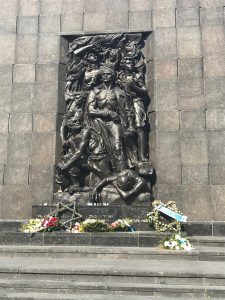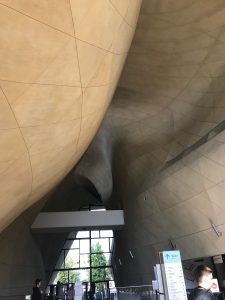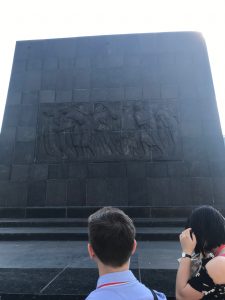
The second tour in Warsaw bridged the pre-war and post-war life of Polish Jews. The tour began with visiting the only building that survived in the heart of the Jewish district in Warsaw. However, there was no sign that stated this historical significance. There was only a general memorial of the Polish resistance. This lack of commemoration demonstrated the difficulty of Poland of remembering this scare in history. Around this area the only physical vestiges that remained was the Jewish studies center. The tour continued to a park which had segregation akin to the discriminatory practices, primarily against the Hasidic Jews. This was appropriately likened to the American pre-civil rights movement. The park had commemorated where the ghetto wall had stood. It memorialized the events of World War II, but there was no commemoration of Jewish life before the war in the park. This was attributed to the lack of Polish Jews in contemporary Poland.
Another point of the tour that was discussed heavily in class was the Warsaw Ghetto uprising and the roles Jewish people had. We saw a memorial, whose shape was similar to a sewer because that was how ghetto fighters operated. We also visited the Monument to the Ghetto Heroes, which commemorated the first Warsaw Ghetto Uprising of 1943. This was a very exaggerated sculpture because these fighters had very poor physical condition. These people were starved, yet the sculptures were very muscular. This was reminiscent of the narrative of the strong working-class heroes that was perpetuated by the Communist party as seen in Nowa Huta. This idea of strong bare-chested men who were idolized as heroes. However, these fighters were not the majority of the inhabitants of the ghetto. The other side of the monument was this scene of starved Jewish families trying to survive. Though, these individuals were heroes in their own right because they kept their kids alive
The last part of the tour was running through the history of Polish Jews in the POLIN Museum of the History of Polish Jews. Even before starting the tour, the architecture could be interpreted as Old Testament tale of Moses and the exodus or the deserts of Israel. The tour was a recap of the timeline the class focused on throughout the semester. It began with the etiological tale of how Jews came to Poland. Their socioeconomic role in the feudal hierarchy. Their assimilation to Polish life, World War I and II, the aftermath, and the anti-Semitic campaign of 1968-1969. One of the major takeaways was the difference between Anti-Judaism vs Anti-Semitism. The former was based on religion only, while the later refers to the Jewish people as a race. The Jewish people faced both, and while religion could be changed, ethnicity was immutable.
In the class discussion, the term “phantom limb” was used to describe the Polish Jews absence as a constant ache to the country. However, with this museum the ache seems to be subsiding as it presents the Polish Jewish narrative in a respectful manner through collaboration with the government and Jewish nongovernmental organizations. This museum demonstrated that the Jewish people should be remembered more for their rich history than being murdered during the Holocaust. 

